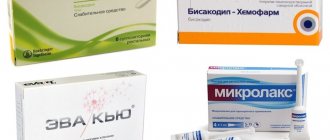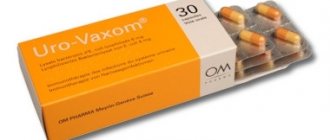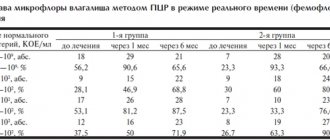Side effects
When using the drug, the following side effects are rarely possible:
From the gastrointestinal tract: nausea, vomiting, discomfort or pain in the epigastrium, laxative effect, the occurrence of erosive and ulcerative lesions, bleeding.
From the nervous system: headache, dizziness, psychomotor agitation, insomnia.
From the hematopoietic organs: anemia, thrombocytopenia, agranulocytosis, leukopenia.
From the urinary system: impaired renal function, cystitis.
Allergic reactions: skin rash, itching, urticaria, exacerbation of bronchial asthma, angioedema, anaphylactoid reactions, anaphylactic shock, bronchospasm, fever, erythema multiforme exudative (including Stevens-Johnson syndrome), toxic epidermal necrolysis (Lyell's syndrome).
From the cardiovascular system: tachycardia, increased blood pressure.
Directions for use and doses
Rectally. The dosage for children depends on the age and body weight of the child.
Post-immunization fever: children under 1 year - 1 supp., over 1 year, if necessary, 1 more supp. in 6 hours
Fever and pain
Single dose - 5-10 mg/kg body weight 3-4 times a day. The maximum daily dose is no more than 30 mg/kg/day.
Children aged 3–9 months (5.5–8.0 kg) - 1 supp. (60 mg) 3 times within 24 hours every 6–8 hours, not more than 180 mg/day; from 9 months to 2 years (8.0–12.5 kg) - 1 sup. (60 mg) 4 times within 24 hours every 6 hours, but not more than 240 mg/day.
Duration of treatment: as an antipyretic - no more than 3 days; as a pain reliever - no more than 5 days.
If fever persists, you should consult your doctor.
Nurofen 60 mg N10 rectal suppositories for children
Release form
Rectal suppositories (for children).
5 suppositories in an aluminum blister. The inner side of the blister is covered with a layer of polyethylene, the outer side is coated with varnish. Two blisters are placed together with instructions for use in a cardboard box.
Package
10 pieces.
pharmachologic effect
Nurofen for children in suppository format is suitable for the youngest children from 3 months to 2 years *. Fights fever and pain, lasting up to 8 hours.
The mechanism of action of ibuprofen, a propionic acid derivative from the group of non-steroidal anti-inflammatory drugs (NSAIDs), is due to inhibition of the synthesis of prostaglandins, mediators of pain, inflammation and hyperthermic reaction. Indiscriminately blocks cyclooxygenase 1 (COX-1) and cyclooxygenase 2 (COX-2), as a result of which it inhibits the synthesis of prostaglandins. In addition, ibuprofen reversibly inhibits platelet aggregation. It has analgesic, antipyretic and anti-inflammatory effects. The analgesic effect is most pronounced for inflammatory pain. The effect of the drug lasts up to 8 hours.
*Depending on the child’s body weight, as specified in the instructions for use of the drug
Indications
Nurofen® rectal suppositories for children are used in children from 3 months to 2 years of age for symptomatic treatment as an antipyretic for acute respiratory diseases (including influenza), childhood infections, other infectious and inflammatory diseases and post-vaccination reactions accompanied by fever bodies.
The drug is used as a symptomatic analgesic for pain of mild or moderate intensity, including toothache, headache, migraine, neuralgia, ear pain, sore throat, sprain pain, muscle pain, rheumatic pain, joint pain and other types of pain.
The drug is recommended for use when taking oral medications (for oral administration) is impossible or in the presence of vomiting.
The drug is intended for symptomatic therapy, reducing pain and inflammation at the time of use, and does not affect the progression of the disease.
Contraindications
- Hypersensitivity to ibuprofen or any of the components included in the drug.
- A history of hypersensitivity reactions (bronchial asthma, bronchospasm, rhinitis, rhinosinusitis, recurrent polyposis of the nose or paranasal sinuses, Quincke's edema, urticaria) in response to the use of acetylsalicylic acid or other NSAIDs.
- A history of bleeding or perforation of a gastrointestinal ulcer caused by the use of NSAIDs.
- Erosive and ulcerative diseases of the gastrointestinal tract (including peptic ulcer of the stomach and duodenum, Crohn's disease, ulcerative colitis) or ulcerative bleeding in the active phase or in history (two or more confirmed episodes of peptic ulcer or ulcerative bleeding).
— Severe liver failure or active liver disease.
— Severe renal failure (creatinine clearance <30 ml/min), progressive kidney disease, confirmed hyperkalemia.
— Decompensated heart failure, the period after coronary artery bypass surgery.
— Blood clotting disorders (including hemophilia, prolongation of bleeding time, tendency to bleed, hemorrhagic diathesis).
— Pregnancy (III trimester).
— Child’s body weight is up to 6 kg.
- Proctitis.
- Intracranial hemorrhage.
Precautions for use
If you have the conditions listed in this section, you should consult your doctor before using the drug.
Concomitant use of other NSAIDs, a history of a single episode of gastric ulcer or ulcerative bleeding of the gastrointestinal tract, gastritis, enteritis, colitis, the presence of Helicobacter pylori infection, ulcerative colitis; bronchial asthma or allergic diseases in the acute stage or in history - bronchospasm may develop; severe somatic diseases, systemic lupus erythematosus or mixed connective tissue disease (Sharpe's syndrome) - increased risk of aseptic meningitis; renal failure, including dehydration (creatinine clearance 30-60 ml/min), fluid retention and edema, liver failure, arterial hypertension and/or heart failure, cerebrovascular diseases, dyslipidemia/hyperlipidemia, diabetes mellitus, peripheral arterial diseases, blood diseases of unknown etiology (leukopenia, anemia); simultaneous use of other medications that may increase the risk of ulcers or bleeding, in particular, oral glucocorticosteroids (including prednisolone), anticoagulants (including warfarin), selective serotonin reuptake inhibitors (including citalopram, fluoxetine , paroxetine, sertraline) or antiplatelet agents (including acetylsalicylic acid, clopidogrel); pregnancy (I-II trimester), breastfeeding period, old age.
Use during pregnancy and breastfeeding
The use of the drug is contraindicated in the third trimester of pregnancy. If possible, the use of ibuprofen should be avoided in the first and second trimesters of pregnancy. There is evidence that ibuprofen can pass into breast milk in small quantities without any adverse effects on the health of the nursing infant.
special instructions
It is recommended to take the drug for the shortest possible course and in the minimum effective dose necessary to eliminate symptoms.
During long-term treatment, monitoring of the peripheral blood picture and the functional state of the liver and kidneys is necessary. When symptoms of gastropathy appear, careful monitoring is indicated, including esophagogastroduodenoscopy, a complete blood count (hemoglobin determination), and a stool test for occult blood. If it is necessary to determine 17-ketosteroids, the drug should be discontinued 48 hours before the study.
Impact on the ability to drive vehicles and other potentially dangerous mechanisms
Patients who experience dizziness, drowsiness, lethargy, or blurred vision while taking ibuprofen should avoid driving or operating machinery.
Compound
One suppository contains the active ingredient ibuprofen 60 mg and excipients: solid fat 1 (Vitepsol N 15), solid fat 2 (Vitepsol W 45).
Directions for use and doses
Nurofen® for children are suppositories specially designed for children. For rectal use. For short term use only.
Read the instructions carefully before using the drug.
Fever (fever) and pain
The dosage for children depends on the age and body weight of the child.
The maximum daily dose should not exceed 30 mg/kg of the child’s body weight with intervals between doses of the drug of 6-8 hours.
Children aged 3-9 months (6.0 kg - 8.0 kg): 1 suppository (60 mg) up to 3 times within 24 hours, no more than 180 mg per day.
Children aged 9 months - 2 years (8.0 kg - 12.0 kg): 1 suppository (60 mg) up to 4 times within 24 hours, not more than 240 mg per day.
The duration of treatment is no more than 3 days. Do not exceed the indicated dose.
If symptoms persist or worsen after taking the drug within 24 hours (in children aged 3-5 months) or within 3 days (in children aged 6 months and older), you should stop treatment and consult a doctor.
Post-immunization fever
1 suppository for children under 1 year of age; if necessary, 1 more suppository after 6 hours. Do not use more than 2 suppositories (120 mg) within 24 hours.
Side effects
The risk of side effects can be minimized if the drug is taken in a short course, at the minimum effective dose required to eliminate symptoms.
Side effects are predominantly dose-dependent. The following adverse reactions were observed with short-term use of ibuprofen in doses not exceeding 1200 mg/day. When treating chronic conditions and with long-term use, other adverse reactions may occur.
The frequency of adverse reactions was assessed based on the following criteria: very common (>= 1/10), common (>= 1/100 to < 1/10), uncommon (>= 1/1000 to < 1/100) , rare (>= 1/10,000 to < 1/1000), very rare (< 1/10,000), frequency unknown (no frequency estimates available).
Blood and lymphatic system disorders
Very rare: hematopoietic disorders (anemia, leukopenia, aplastic anemia, hemolytic anemia, thrombocytopenia, pancytopenia, agranulocytosis). The first symptoms of such disorders are fever, sore throat, superficial oral ulcers, flu-like symptoms, severe weakness, nosebleeds and subcutaneous hemorrhages, bleeding and bruising of unknown etiology.
Immune system disorders
Uncommon: hypersensitivity reactions - nonspecific allergic reactions and anaphylactic reactions, reactions from the respiratory tract (bronchial asthma, including its exacerbation, bronchospasm, shortness of breath, dyspnea), skin reactions (itching, urticaria, purpura, Quincke's edema, exfoliative and bullous dermatoses, including toxic epidermal necrolysis, Stevens-Johnson syndrome, erythema multiforme), allergic rhinitis, eosinophilia.
Very rare: severe hypersensitivity reactions, including swelling of the face, tongue and larynx, shortness of breath, tachycardia, hypotension (anaphylaxis, Quincke's edema or severe anaphylactic shock).
Gastrointestinal disorders
Uncommon: abdominal pain, nausea, dyspepsia.
Rare: diarrhea, flatulence, constipation, vomiting.
Very rare: peptic ulcer, perforation or gastrointestinal bleeding, melena, hematemesis, ulcerative stomatitis, gastritis.
Frequency unknown: exacerbation of ulcerative colitis and Crohn's disease.
Urinary system and liver disorders
Very rare: acute renal failure, especially with long-term use, in combination with an increase in urea levels in the blood plasma and the appearance of edema, papillary necrosis, liver dysfunction, hepatitis.
Nervous system disorders
Uncommon: headache.
Very rare: aseptic meningitis (in patients with autoimmune diseases).
Cardiovascular disorders
Frequency unknown: heart failure, peripheral edema, with long-term use there is an increased risk of thrombotic complications (for example, myocardial infarction, stroke), increased blood pressure.
Disorders of the respiratory system and mediastinal organs
Frequency unknown: bronchial asthma, bronchospasm, shortness of breath.
Others
Very rare: edema, including peripheral edema.
Laboratory indicators
- hematocrit or hemoglobin (may decrease)
- bleeding time (may increase)
- plasma glucose concentration (may decrease)
- creatinine clearance (may decrease)
- plasma creatinine concentration (may increase)
- activity of “liver” transaminases (may increase)
If side effects occur, you should stop taking the drug and consult a doctor.
Drug interactions
The simultaneous use of ibuprofen with the following drugs should be avoided:
Acetylsalicylic acid: with the exception of low doses of acetylsalicylic acid (no more than 75 mg per day) prescribed by a doctor, since combined use may increase the risk of side effects. With simultaneous use, ibuprofen reduces the anti-inflammatory and antiplatelet effect of acetylsalicylic acid (an increase in the incidence of acute coronary insufficiency in patients receiving small doses of acetylsalicylic acid as an antiplatelet agent is possible after starting ibuprofen).
Other NSAIDs, including selective COX-2 inhibitors: The simultaneous use of two or more drugs from the NSAID group should be avoided due to a possible increased risk of side effects.
Use with caution simultaneously with the following medications:
Anticoagulants and thrombolytic drugs: NSAIDs may enhance the effect of anticoagulants, in particular warfarin and thrombolytic drugs.
Antihypertensives (ACE inhibitors and angiotensin II antagonists) and diuretics: NSAIDs may reduce the effectiveness of drugs in these groups. Diuretics and ACE inhibitors may increase the nephrotoxicity of NSAIDs.
Corticosteroids: Increased risk of gastrointestinal ulceration and gastrointestinal bleeding.
Antiplatelet agents and selective serotonin reuptake inhibitors: increased risk of gastrointestinal bleeding.
Cardiac glycosides: simultaneous administration of NSAIDs and cardiac glycosides can lead to worsening heart failure, a decrease in glomerular filtration rate and an increase in the concentration of cardiac glycosides in the blood plasma.
Lithium preparations: there is evidence of the likelihood of an increase in the concentration of lithium in the blood plasma during the use of NSAIDs.
Methotrexate: there is evidence of the likelihood of an increase in the concentration of methotrexate in the blood plasma during the use of NSAIDs.
Cyclosporine: increased risk of nephrotoxicity when NSAIDs are administered concomitantly with cyclosporine.
Mifepristone: NSAIDs should be started no earlier than 8 to 12 days after taking mifepristone, as NSAIDs may reduce the effectiveness of mifepristone.
Tacrolimus: When NSAIDs and tacrolimus are coadministered, the risk of nephrotoxicity may increase.
Zidovudine: Concomitant use of NSAIDs and zidovudine may result in increased hematotoxicity. There is evidence of an increased risk of hemarthrosis and hematomas in HIV-positive patients with hemophilia who received concomitant treatment with zidovudine and ibuprofen. Quinolone antibiotics: In patients receiving concomitant treatment with NSAIDs and quinolone antibiotics, the risk of seizures may be increased.
Overdose
In children, overdose symptoms may occur after taking a dose of the drug exceeding 200 mg/kg of the child’s body weight.
Symptoms:
nausea, vomiting, epigastric pain or, less commonly, diarrhea, tinnitus, headache and gastrointestinal bleeding. In more severe cases, manifestations from the central nervous system are observed: drowsiness, rarely - agitation, convulsions, disorientation, coma. In cases of severe poisoning, metabolic acidosis and increased prothrombin time, renal failure, liver tissue damage, decreased blood pressure, respiratory depression and cyanosis may develop. In patients with bronchial asthma, exacerbation of this disease is possible.
Treatment:
symptomatic, with mandatory maintenance of airway patency, monitoring of ECG and vital signs until the patient’s condition is normalized. Frequent or prolonged seizures should be treated with intravenous diazepam or lorazepam. If bronchial asthma worsens, the use of bronchodilators is recommended.
Storage conditions
At a temperature not higher than 25°C. In a dry place.
Best before date
2 years.
Do not use a drug that has expired.



